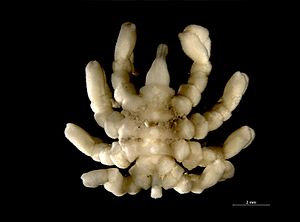Knotty woodlouse spider
| Knotty woodlouse spider | ||||||||||||
|---|---|---|---|---|---|---|---|---|---|---|---|---|

Knotty woodlouse spider ( Pycnogonum litorale ) |
||||||||||||
| Systematics | ||||||||||||
|
||||||||||||
| Scientific name | ||||||||||||
| Pycnogonum litorale | ||||||||||||
| Strøm , 1762 |
The knotty woodlouse spider ( Pycnogonum litorale ) is a species from the class of woodlouse spiders (Pycnogonida).
features
The animals have a body length of 15 to 18 millimeters and are whitish or yellowish in color. The chelicerae and pedipalps are completely regressed and the animals have a strong, blunt trunk in their place. Behind the trunk there is a mound with four small lens eyes. An egg carrier (Oviger) is only developed in the male. The legs are relatively short and strong.
Occurrence
The species is widespread in the Atlantic and the North Sea and occurs from the intertidal zone to deeper water areas. They can sometimes be found in large numbers on stony areas, groynes or in harbors.
Way of life
Knotty woodlice spiders suckle on sea anemones , which they prick with their powerful proboscis. During mating, the male takes over the eggs with the egg carrier at the genital opening of the female. The eggs stick together through a secretion secreted by the male. The male carries the eggs until the young hatch. These initially suckle on polyps , especially of the genus Clava .
supporting documents
Individual evidence
- ↑ a b c Heiko Bellmann : Kosmos-Atlas arachnids of Europe. Extra: freshwater crabs, woodlice and millipedes . 3. Edition. Franckh-Kosmos, Stuttgart 2006, ISBN 978-3-440-10746-1 .
literature
- Heiko Bellmann : Cosmos Atlas Arachnids of Europe. Extra: freshwater crabs, woodlice and millipedes . 3. Edition. Franckh-Kosmos, Stuttgart 2006, ISBN 978-3-440-10746-1 .